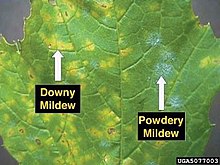
Back بياض زغبي Arabic Несапраўдная мучністая раса Byelorussian Мана Bulgarian Plíseň révy vinné Czech Falscher Mehltau German Mildiu Basque سفیدک کرکی Persian Mildiou French Կեղծ ալրացող Armenian Penyakit bulai ID
| Downy mildew | |
|---|---|
 Example of downy mildew (left) along with powdery mildew on a grape leaf | |
| Causal agents | oomycetes |
| Hosts | plants |
Downy mildew refers to any of several types of oomycete microbes that are obligate parasites of plants. Downy mildews exclusively belong to the Peronosporaceae family. In commercial agriculture, they are a particular problem for growers of crucifers, grapes and vegetables that grow on vines. The prime example is Peronospora farinosa featured in NCBI-Taxonomy[1] and HYP3.[2] This pathogen does not produce survival structures in the northern states of the United States, and overwinters as live mildew colonies in Gulf Coast states. It progresses northward with cucurbit production each spring. Yield loss associated with downy mildew is most likely related to soft rots that occur after plant canopies collapse and sunburn occurs on fruit. Cucurbit downy mildew only affects leaves of cucurbit plants.
- ^ NCBI-Taxonomy – ncbi.nlm.nih.gov
- ^ HYP3 – ncbi.nlm.nih.gov